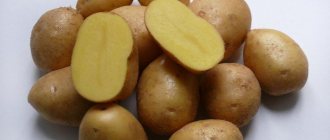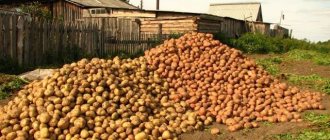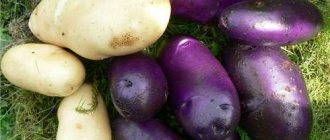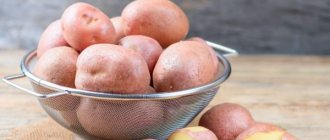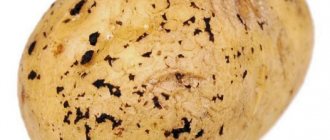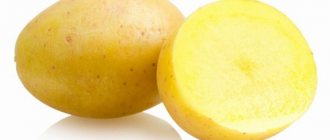Vegetable growing » Potatoes
0
1499
Article rating
Kira Stoletova
Those who have at least once planted potatoes will appreciate the Cornflower variety. He stands out favorably against the background of other representatives of the culture. The vegetable has excellent varietal characteristics and also boasts an unusual appearance of the fruit.
Characteristics of potatoes of the Cornflower variety
The variety is very productive. It is this feature that makes it a favorite guest in garden beds.
Characteristics of potatoes of the Cornflower variety
Those who have at least once planted potatoes will appreciate the Cornflower variety. He stands out favorably against the background of other representatives of the culture. The vegetable has excellent varietal characteristics and also boasts an unusual appearance of the fruit.
Characteristics of potatoes of the Cornflower variety
The variety is very productive. It is this feature that makes it a favorite guest in garden beds.
Features of the variety
Cornflower potato description, which is in many ways similar to the popular Soviet varieties Tsyganka and Sineglazka. Root crops with unusual colors grow well throughout Russia, with the exception of its northern regions.
The variety is also unique for its unusually beautiful bush. Dark green large leaves grow densely on strong, erect stems. During the flowering period, the tops of the shoots are crowned with a scattering of purple flowers.
Advantages and disadvantages
The characteristics of Cornflower potatoes include both positive and negative sides.
There are significantly more advantages, so we can recommend this variety for growing and obtaining a bountiful harvest.
Potato Vasily has the following advantages:
- The variety is mid-early, so its tubers are much larger than those of the early variety.
- Potatoes are ready for harvesting 65-70 days after the first shoots appear.
- The color of the tuber shell is very decorative, although it is lost during heat treatment.
- The tubers contain more vitamin C than half a lemon. Among other things, it contains carotenoids. These substances act as antioxidants and prevent the formation of free radicals.
- The bush is compact and erect, and requires less hilling.
- High yield, as well as the ability to resist cancer of nightshades.
- Vasily potatoes are used to prepare first and second courses. When boiled, the tubers crack, but do not become crumbly. This happens due to the high starch content in the vegetable.
It is worth noting the disadvantages that a gardener will have to face:
- Lack of immunity to pathogens of dry and ring rot;
- Susceptible to cyst nematode;
- The tuber germinates quickly, thanks to the “eyes” located on the very surface of the skin, which makes it difficult to store in winter.
- On acidified soil, the vegetable produces meager yields of very small tubers, which are often affected by scab.
Despite all the shortcomings in the description of the potato variety, Cornflower, it has very good reviews among gardeners. And in order to get high-quality tubers, it needs to be fertilized, hilled and watered.
Characteristics and features of the variety
The Azart potato, described below, is a mid-early variety for table use; the time from planting to ripening is 80-90 days. Adapts to any soil and climate of the area where growing potatoes is possible; contains up to 20% dry matter. Productivity is high. Tolerates short-term waterlogging well.
A bush of medium height, spreading, with many matte dark green leaves. Blooms 45-50 days after planting. The flowers are white; berries are rarely formed in their place.
Tubers have a regular elongated oval shape, are compactly located in the ground, weight - 90-110 g. The number of tubers in a bush ranges from seven to ten.
The skin is reddish in color with shallow, small eyes. The pulp is light yellow with good taste. Doesn't darken when cooked. Suitable for preparing salads, soups, frying.
Interesting. There is little damage to the tubers during harvesting and transportation.
This varietal potato stores well, which allows it to be used in the autumn-winter period.
Potatoes are a valuable food product. Three hundred grams of the product contain the daily requirement of carbohydrates, phosphorus, and potassium.
The pulp contains elements necessary for the body:
Potatoes contain vitamin C, almost all amino acids found in edible plants, starch, and fiber.
Potato pulp contains elements necessary for the body
Planting potatoes
Before planting, the tubers must be germinated
In order for the planting material to be well preserved, it is recommended to keep it in a cool, dark room in winter. The ideal option would be a dry basement or storage room.
In mid-February, the tubers are taken out and placed in one layer for germination. The potatoes are sprinkled with sawdust on top and constantly moistened with a spray bottle.
Soil preparation
The place for the beds must be thought out in advance, taking into account crop rotation. Rotted manure or humus is added to the ground. The soil itself is dug up to the depth of one bayonet, leaving large lumps unbroken. This is done to control pests.
You can also sow the area with rye, wheat, mustard, rapeseed, etc. These plants play the role of green manure and enrich the soil with organic matter. As soon as the young greenery reaches 10 cm, the plants are mowed down, or the area is completely dug up along with the green manure. In the spring, the digging is repeated, and complex fertilizers, rotted humus or bird droppings are added to the soil.
Planting potatoes
After the danger of returning night frosts has passed, potato tubers are planted in open ground. Before this, chemical fertilizers, chicken or cow droppings, which have managed to rot, are placed in the holes or trenches. You can also use ash as a source of microelements.
Sprouted tubers must be inspected and planted with their buds on top. This will speed up the germination process. Some summer residents practice planting only parts of tubers or even their peelings. The depth of placement will depend on the density of the soil. The lighter it is, the deeper you can plant the vegetable.
Landing
Potatoes are planted after the end of spring frosts. The soil should reach a temperature of +10-15 degrees. The site is selected and prepared in advance:
- Optimal predecessors are legumes and winter crops, as well as cucumbers, zucchini, pumpkin, carrots, garlic, and onions.
- Heavy clay soils are lightened by adding sand and peat for digging.
- In autumn, the area is cleared of old plants and humus or compost is added with organic fertilizers in an amount of 5-10 kg per 1 sq. m. m depending on the depletion of the soil.
- In the spring, they are dug up again with mineral fertilizers.
- If the acidity exceeds neutral, add dolomite flour or slaked lime.
The tubers are sorted out, laid out in a thin layer in a cool, bright place (+12-15) and allowed to germinate. By the time of planting, they should have sprouts 2-3 cm long. The day before planting, the planting material is sprayed with a solution of potassium permanganate and stimulants.
Make holes according to the pattern 30 by 60 or 30 by 70 cm with a depth of 10 cm on light soil and 4-5 cm on heavy soil. Place a little nitrophoska or ash in each and carefully bury the potatoes.
Potato care
The Cornflower potato variety, whose characteristics describe it as universal, requires cultivation on fertile soil. Fertilizing, timely watering and treatment against parasites significantly affect the yield and its quality.
Weeding is important for plants
It is also important to remove weeds by weeding or mulching. You should not use pine needles as mulch, because... it greatly acidifies the soil. During the entire growing season, bushes are hilled at least 3 times. The procedure is repeated until there is a gap between the hills.
Watering
From the moment the first shoots appear until flowering begins, it makes no sense to water the plantings, except in very dry and hot weather. When the plant begins to flower, tubers begin to form on the roots. At this time, the entire birth depends on soil moisture.
Watering is carried out in this way:
- water is poured under the root, and not on top of the tops;
- after watering, the soil is loosened, thereby improving aeration;
- bushes are hilled, raking earth onto the stems.
Water the plant mainly in the evening or in cloudy weather. It is not recommended to use sprinklers for these purposes, because moisture getting on the tops can provoke the development of late blight.
Fertilizer
To obtain maximum crop productivity, fertilizing is necessary. Fertilization begins immediately before flowering. Before this, the soil is well moistened so that it is easier for the bush to absorb nutrients from it.
The following is used as fertilizing:
- chicken droppings soaked in water for 2 weeks in a ratio of 1:10;
- 1 tbsp. l of urea diluted in 10 l of water, calculated at 400-500 ml for each plant;
- soaked varietal grass prepared by fermentation;
- infused manure at a ratio of 1:10 with water.
Growing and care
Before the budding phase, the bushes are watered only in extreme heat or during prolonged drought. With the beginning of flowering, abundant watering is required to a depth of at least 50 cm with slightly warmed water. It is carried out in the evenings, then the soil is carefully loosened.
The number of tubers that will develop on the bush depends on watering during this period.
Plants are periodically earthed up. Feed 3 times per season. Fertilizers are applied only along with watering or in moist soil, otherwise the roots will get burned.
- After germination, nitrogen fertilizer is applied: a solution of chicken manure 10% or 1 tbsp. l. urea per bucket of water.
- During budding, solutions of superphosphate and potassium sulfate are added.
- At the end of flowering, prepare a solution of a quarter liter of mullein and 20 g of superphosphate per 10 liters of water.
What kind of potato is this?
Cornflower is a table variety bred at VNIIKH named after. A. G. Lorja for cultivation in the central regions of the country. These are mid-early ripening potatoes. It takes 80–90 days from planting to harvest.
Cornflower is grown following standard agricultural practices. It is distinguished by average resistance to diseases and parasites. We are talking about potato cancer, scab, late blight, and viruses. The plant is susceptible to nematodes.
Potatoes of this variety are used for preparing dietary dishes and baby food. It contains from 12 to 15% starch. Potatoes are distinguished by a high content of ascorbic acid, tocopherol, and carotenoids. Thanks to its rich vitamin composition, the variety is good for health.
Two potatoes contain the same amount of vitamin C as one lemon. The carotenoids present in tubers have antioxidant properties. They promote the normal functioning of the genitourinary system and protect the body from fungal and bacterial infections.
Origin and development
The Cornflower variety is the result of 5 years of work by domestic breeders. It was bred by crossing Chugunka with the hybrid D-31-88. The work of breeders was aimed at creating a fortified vegetable crop, whose root crops, when grown, would absorb less nitrates compared to traditional potato varieties.
Cornflower was registered in the Russian Federation register under No. 9253214 in 2014. The patent for it belongs to the All-Russian Research Institute of Potato Farming named after. A. G. Lorkha.
Cornflower was bred for cultivation mainly in the central part of the country. It is ideal for the conditions of the Central, Central Black Earth, and Northwestern regions of Russia.
Distinctive features, appearance
As can be seen in the photo, the Cornflower variety is characterized by elongated oval tubers. They are covered with a smooth violet-blue skin with small superficial eyes. The sprouts are also characterized by a dark purple color.
The pulp is creamy, juicy and dense in consistency. It is moderately starchy, mealy and watery.
Potatoes have good taste characteristics. During the cooking process, the tubers are moderately boiled, and the flesh does not darken.
The uniformity of size, shape and elasticity of potatoes makes the variety convenient for storage.
Description of the variety
Felox potatoes are early ripening varieties. From the moment the tubers are planted until the harvest begins, 65-75 days pass.
The variety is popular due to its high productivity and universal use of root crops. Gives an excellent harvest even under unfavorable climatic conditions and sudden temperature changes. Famous for its taste.
Origin and development
The Felox potato variety was bred by breeders of the Saka Palanzenzucht company (Germany). The variety has become popular in Europe, India, China, and the CIS countries. This is explained by the fact that the crop easily adapts to different climatic conditions, tolerates temperature changes well and produces crops on any soil.
Since 1999 it has been grown in Russia. Distributed by the Sedek farm. The variety is recommended for cultivation in the Middle Volga region.
Chemical composition, trace elements and vitamins
Potato tubers contain proteins, carbohydrates, many vitamins, micro- and macroelements.
Vitamin content in 100 g of raw potatoes:
- A - 2.8 mcg;
- B1 - 0.15 mg;
- B2 - 0.6 mg;
- B5 - 0.32 mg;
- B6 - 0.31 mg;
- B9 - 0.8 mg;
- C - 22 mg;
- E - 0.12 mg;
- RR - 1.36 mg;
- beta-carotene - 0.02 mg.
Macronutrients:
- calcium - 11 mg;
- magnesium - 21 mg;
- sodium - 4.5 mg;
- potassium - 570 mg;
- phosphorus - 50 mg;
- sulfur - 30 mg;
- chlorine - 45 mg.
Microelements:
- iron - 0.92 mg;
- zinc - 0.3 mg;
- iodine - 5.2 mcg;
- copper - 138 mcg;
- manganese - 0.16 mg;
- fluorine - 28 mcg;
- boron - 118 mcg;
- aluminum - 855 mcg.
Calorie content - 80 kcal. Nutritional value per 100 g of product:
- proteins - 2.5 g;
- fats - 0.42 g;
- carbohydrates - 18 g;
- starch - 17 g;
- ash - 1 mg;
- water - 77 g;
- dietary fiber - 1.5 g;
- organic acids - 0.25 g.
Characteristics of tubers, description of appearance and yield
The variety is characterized by oblong-shaped tubers. The weight of each varies between 100-120 g, in rare cases individual specimens reach 200 g. The tubers have an amber-colored peel, the core is light when cut. The variety is characterized by high taste qualities and is suitable for preparing any culinary dishes. The potatoes do not darken when peeled and cut. Tubers retain their presentation by 97% during long-term transportation.
The bushes of the variety are erect, well leafy. The leaves are large, toothed, dark green. The inner side of the sheet is glossy. The flowers are small, dark lilac in color.
This is an early ripening variety, from planting to harvest it takes 65-75 days. One plant produces 18-25 tubers. The yield of the variety reaches 550-600 centners per hectare.
What regions is it suitable for?
The variety performed well in all regions of Russia, but the best yield results were achieved in the Volga, Volga-Vyatka, and Northwestern regions.
What is the difference from other varieties
Unlike other varieties, Felox potatoes adapt well to growing conditions in regions with unfavorable climates. The variety tolerates drought and cold well, as well as sudden changes in air temperature. The variety can be grown on various types of soil.
How to grow this variety
Cornflower is easy to grow and easy to care for. To get a high yield, it is important to correctly select seed material, prepare and fertilize the soil.
Dates, scheme and rules of planting
Potato variety Cornflower is replanted in the middle or end of March, when there are no longer night frosts. Seed material is prepared starting from the last month of winter:
- For planting, potatoes of the correct shape are selected, without damage or signs of disease. The optimal weight of each is from 55 to 75 g.
- The tubers are evenly laid out in one layer for germination. It is advisable to sprinkle them with sawdust and irrigate them with water daily, using a spray bottle for this purpose.
- The day before, the seed material is treated with a solution of copper sulfate prepared from 10 liters of water and 1 tbsp. l. copper sulfate powder. This measure will protect potatoes from diseases.
- Having carried out preventive spraying, the tubers are dried and transferred to a warm, well-lit place, where they will warm up and germinate.
Cornflower is a light-loving variety. It is preferable to grow it in a garden area that is open to sunlight and protected from drafts.
Before planting, the soil is treated to create a comfortable temperature and air conditions. Organic fertilizers are added to heavy soil, and peaty-boggy soil is pre-cultivated.
It is advisable to plant in the ground where green manure previously grew. It is acceptable to grow Cornflower after beans, cabbage, cucumbers, and pumpkins.
Potatoes weighing 55–75 g are planted in accordance with one of the following schemes:
To get a good harvest, it is important to follow the following recommendations:
- 14 days after planting, when shoots appear en masse, the inter-row space is loosened deeply (7 cm).
- If late spring frosts are predicted, the seedlings mount high.
- The first hilling is started when the tops reach a height of 15 cm, the second - when they close.
- Plants are watered as needed, and during the flowering period, when tubers are formed, they begin to actively water the bushes. 1 bush requires at least 2 liters of water.
- In drought conditions, mandatory irrigation is required. It is carried out at least 3 times during the growing season.
- When growing potatoes of the Cornflower variety, it is necessary to treat late blight with preparations with a high copper content. It is carried out at least 3 times per season.
- An alternative to regular weeding is mulching the soil. It reduces the growth rate of weeds and conserves moisture.
Potato variety Cornflower
Cornflower is a mid-early variety of potato (Solanum tuberosum) for table use. Suitable for dietary purposes. Brought out in the Moscow region by specialists from the Federal State Budgetary Institution “VNII Potato Farming named after. A.G. Lorha." It was obtained by crossing the Chugunka variety and the numbered hybrid D-31−88. In 2014, 7 years after submitting an application for admission, it was included in the state register of breeding achievements of the Russian Federation. Zoned in the Central region (Bryansk, Vladimir, Ivanovo, Kaluga, Moscow, Ryazan, Smolensk, Tula regions). It is distinguished by a blue-violet color of the peel.
The period from the appearance of full shoots to harvest is 80-100 days, in some regions a little longer.
Plant of medium height, intermediate type. Cornflower's stems are strong and semi-erect. The leaves are medium sized, open, dark green in color. The corolla is small, pinkish-violet in color. The intensity of anthocyanin coloring on its inner side is weak or medium.
The root system of potatoes is quite powerful; about 15 medium-sized tubers, weighing 77-112 grams each, can be formed on one plant; the amount of non-commercial fines is minimal. The tubers are aligned, have an elongated oval shape, often regular. The peel is thin, smooth, blue-violet in color; when cooked, the intensity of the blue tint is lost. When cut, the pulp is white or light cream in color; small areas with pink-violet pigment may be observed. The eyes are small, superficial, almost invisible.
The variety performed well during state tests. The marketable yield amounted to 93−256 c/ha, at the level and 67 c/ha below the Nevsky standards. The maximum amount was obtained in the Moscow region - 482 c/ha, which is comparable to the Bryansk delicacy standard. Marketability of tuber crops is 71−94%, keeping quality is 96%.
Cornflower's taste is very good. The tubers are medium boiled, suitable for preparing any dishes, but are especially well suited for pureeing, boiling in their “jacket” and peeled form, baking, and stuffing. When cooked, they crack, but do not lose their shape. The pulp is slightly mealy, not watery, its starch content is 10-12%. These potatoes have high antioxidant activity, which makes them ideal for dietary nutrition.
The variety is moderately demanding on soil and climatic conditions. The best yield is shown on light fertile soils in regions with a mild climate, especially in the Central. From an agrotechnical point of view, the variety is absolutely simple and does not require special attention, but it will certainly respond to good care by increasing the yield and the number of marketable potatoes. Here are some tips to help you get the best results.
- Before planting, tubers should be selected and calibrated. Medium-sized specimens without mechanical damage or signs of disease are better suited for further cultivation. It is highly advisable to treat the seed material with disinfectants against diseases and insects, as well as, if desired, with growth stimulants.
- The area for planting Cornflower should be well prepared in advance - fertilized, plowed, harrowed. It is important to choose soil on which crops such as legumes, green manure, cabbage, onions, beets, cucumber, garlic, and zucchini have previously grown. Do not plant tubers in the soil after other nightshades! This can lead to potato infection with diseases characteristic of this crop, in particular late blight.
- During the growing season of plants, do not forget about standard agrotechnical measures. Hilling up, loosening the soil, timely preventive treatments against diseases and pests, regular watering and fertilizing - all this will have a very positive effect on the yield. By the way, applying increased doses of fertilizers will help reduce the number of small tubers. But do not get carried away with nitrogen-containing complexes - their excessive amount in the soil can lead to increased growth rates of tops to the detriment of tuber formation.
- Do not forget to replace the seed material in a timely manner. Our hero appeared on the wide potato market not so long ago, so there is no information about his tendency to degenerate. There is one more thing worth mentioning at this point. In Russia, there is “varietal confusion” - varieties with blue-violet skin and white flesh are often very similar in appearance to tubers, which is why they are often confused. Thus, for example, the Blue Danube or the Gypsy may be mistaken for Cornflower, and someone says that Cornflower does not exist at all. It is very difficult to understand this kaleidoscope of opinions, so the only right decision would be to purchase seed material from the originator or from a trusted, bona fide seller.
The variety is resistant to golden cyst nematode, cancer, moderately resistant to banded and wrinkled mosaic. It is relatively resistant to late blight on tops and tubers.
Gardeners greatly value this variety for its excellent taste, high yield, good keeping quality and excellent presentation of the tubers. Despite its rather exotic appearance, these potatoes quickly gained popularity in garden plots.
The disadvantages include, first of all, the poor resistance of tubers to mechanical damage due to their thin skin. You can also add here the relative vulnerability to late blight. Another small drawback is, as unexpected as it may sound, the blue-violet color of the peel. From our own experience, we can say that during harvesting, cornflower tubers are much more difficult to find in the ground than tubers of ordinary red- or yellow-skinned varieties.
Potato cultivation is officially carried out by: Agrocenter Korenevo LLC in the Moscow region, Fat-Agro LLC in North Ossetia-Alania, Redkinskaya Agro-Industrial Company LLC in the Tver region, APK Lyubovskoye LLC in the city of Arkhangelsk.
Collection, storage and use of crops
Providing good conditions for plants, using high-quality seed and fertilizers is the key to obtaining a high yield. It is collected in late summer or early autumn.
Cornflower potatoes can be stored for 3 to 4 months. In conditions of high humidity there is a risk of tubers sprouting.
A dry place out of direct sunlight is suitable for storage. It is important to ensure good air circulation and temperature conditions not exceeding +3°C.
Potatoes of this variety have pleasant taste characteristics. It is eaten boiled, fried and baked.
Potatoes "Ballad": mid-season and very productive variety
Categories: potatoes Potatoes "Ballad" are mid-season varieties for table use Potatoes "Ballad" are mid-season varieties for table use. The variety is able to demonstrate high yields and form high-quality tubers even under unfavorable weather and climatic conditions.
Potatoes: basic information
|
|
Photo: | |
Description of the variety
As a rule, gardeners are primarily interested in the description of a variety, because it allows them to assess the prospects of cultivating a plant in their own plot.
Potato bushes "Ballad" are very powerful and are characterized by strong growth, as well as good foliage. The average height of one bush is about 0.8 m. The tubers are uniform in shape, oval, medium in size or quite large, covered with a smooth, light, whitish skin. The eyes are superficial. Potato tubers have pale yellow, creamy flesh.
Potato bushes "Ballad" are very powerful and characterized by strong growth
Advantages and disadvantages
Potatoes called “Ballad” are very productive and form a powerful nest in the soil, filled with a large number of large one-dimensional tubers. The variety has other advantages:
- excellent taste: potatoes are perfect for cooking in various ways, including frying;
- complex resistance to late blight and many viral diseases;
- high productivity from each square meter of sown area;
- excellent shelf life of the harvested crop without reducing taste and marketability.
On average, with proper care, from each bush it is possible to collect from 8 to 20 large tubers, the weight of which most often exceeds 115 grams.
Potatoes "Ballad": harvesting (video)
Timing and features of planting
When planting varietal potatoes “Ballad” in May or the first ten days of June, the main harvest will occur in August or early September. It is advantageous to propagate the plant using true or botanical seed material, which reduces the cost of preserving planting material.
Planting botanical seed material in the form of tuber sets allows you to obtain potatoes that are completely free from various diseases. The tubers obtained in this way for the next year provide a yield of about 250 kg per hectare of land when using 12 kg of potatoes as planting material. Tubers should be planted at a distance of 25-45 cm, deepening them by about 5-6 cm.
In the autumn, when digging up an area for growing potatoes, it is necessary to add rotted manure to the soil. In the spring, it is very important to apply a mixture of peat and sand for planting at the rate of 10 kg per square meter of area. Potatoes of the "Ballad" variety can be cultivated in such ways as trench, smooth and ridge.
Potatoes called "Ballad" are among the most productive
Timely and correct measures for caring for potatoes after planting are a prerequisite for obtaining a large and high-quality harvest. Caring for potato plantings is not at all difficult, but there are several mandatory rules that help you get a high yield.
- On large planting areas, it is best to harrow the soil a week after planting potato tubers.
- Watering is one of the important factors that have a significant impact on the yield and quality of potatoes. In dry summers, only three waterings are sufficient.
- Potatoes are very responsive to mixed fertilizing with both organic matter and various mineral fertilizers. It is advisable to carry out three feedings during the season.
- When pollinating potato tops with ordinary wood ash, gardeners have an excellent opportunity to reduce the risk of bushes being damaged by the Colorado potato beetle, as well as prevent plant rotting in high humidity conditions.
Planting botanical seed material in the form of tuber sets allows you to obtain potatoes completely free from various diseases.
It is very important to keep the potato planting clean and carry out regular weeding followed by shallow loosening. If you hill up potato plantings correctly and on time, you can improve the yield by almost 30%. In the Non-Black Earth Region, it is most profitable to harvest this potato variety no later than the first ten days of August, which allows you to obtain a high, and most importantly, high-quality harvest.
After reading the corresponding article on our website, you can learn about how to grow purple potatoes on your plot.
Reviews from gardeners
Choosing the most worthy potato variety that you would like in all respects is very difficult. Reviews from gardeners who cultivate several varieties in their garden plots characterize the “Ballad” variety very positively. Summer residents, as a rule, are satisfied with the yield of this variety, as well as the taste of the harvested crop.
Choosing a potato variety (video)
Judging by the reviews of vegetable growers who grew potatoes of this variety from seed material from agro, in the second year of cultivation, each bucket of seed potatoes yielded four buckets of harvest. Potato tubers pleasantly surprise with both their appearance and taste. All potatoes grow evenly and quite large. They are not overcooked and when cooked are very aromatic and tasty.
DachaDecor.ru
Advantages and disadvantages of the variety
Among the advantages of the Cornflower variety:
- the possibility of obtaining a harvest 70 days after planting;
- no need for frequent hilling due to the compactness of the bush;
- high yield;
- resistance to diseases and pests;
- high content of vitamins, antioxidant properties;
- pleasant taste.
Among the few disadvantages are:
- plant susceptibility to nematodes and rot pathogens;
- rapid germination of tubers, making it difficult to store the crop in winter;
- in acidic soil conditions the variety does not produce a good harvest.
For which regions is it best suited?
Breeders developed the Cornflower variety for cultivation in the central part of Russia. Plants feel good throughout the country, except for its northern part. The culture is undemanding to soil and climate.
The maximum yield is achieved when grown on light, fertile soil in the climatic conditions of the central regions.
Description of the potato variety Cornflower
Potato Cornflower is a mid-early table variety. It is one of the types of dietary potatoes. Scientists from the Federal State Budgetary Institution “VNII Potato Farming named after. A.G. Lorha." The variety was bred by crossing the Chugunka variety and the hybrid specimen D-31-88. In 2007, the State Register of the Russian Federation received an application to include this variety in the list. It was adopted only 7 years later, in 2014. Cornflower is recommended for cultivation in the Central region of the Russian Federation.
In this publication you will find a full description of the variety, photos of tubers and reviews from summer residents who have managed to get acquainted with the dietary potato variety.
Farmer reviews
Although the Cornflower variety is new, it has many positive reviews from farmers and gardeners.
Tatyana, Ryazan: “Cornflower is similar to the Blue Danube and Tsyganka varieties. A little small, but there are a lot of potatoes in the bush. Disadvantage: affected by scab.”
Irina, Kursk: “I planted Cornflower, Golubizna, Kolobok and Charodey on the plantation. Cornflower gave the largest harvest (0.5 kg yielded 12–15 kg). I don’t really like that the variety gets a little soft when cooked.”
Nina, Nizhny Novgorod: “Cornflower potatoes do not like overly alkaline or acidic soil. To determine if the soil acidity is suitable for growing this variety, pay attention to the weeds growing in the area. If dandelions with coltsfoot and wheatgrass bloom profusely on the plantation, you can safely plant Cornflower. It will feel great in such land and will produce a good harvest.”
Potatoes Vasily - description of the variety
Due to its novelty and low prevalence, there is little information about it. Basil potatoes have the following characteristics: good resistance to drought, resistance to a large number of diseases and crop pests.
Ripening time and yield
Vasily belongs to the mid-season varieties, with a standard ripening period of 90-100 days. The average yield reaches 67 tons per hectare.
Important! The exact timing of ripening depends on the date of planting of seed material, weather conditions, location of the summer cottage and compliance with care rules.
Disease resistance
The culture shows good resistance to potato golden nematode and cancer. It is practically not subject to attacks from late blight of fruits. Not protected from attacks by the Colorado potato beetle.
The main advantages and disadvantages of the variety
The advantages of culture include:
- the first harvest can be carried out 70 days after the appearance of the first shoots;
- large tubers - plants with an average ripening period produce larger potatoes than early varieties;
- due to the compactness and direct growth of the bush, it requires fewer hillings;
- resistance to potato blight;
- good yield.
Potatoes have fewer disadvantages; the main problem is a poor reaction to excessively wet soil. The crop is susceptible to attacks by insect pests.
Planting and growing potatoes of the Vasily variety
Regardless of the quality characteristics of the seed material, it is necessary to carefully select it and correctly carry out preliminary preparation and planting work. Improper care can ruin any seeds, including extra-class varieties.
Preparing for landing
Three weeks before the expected date of planting the potatoes, they are transferred to a warm place, placed in boxes or on plastic film in one row. Regular spraying will allow the tubers to sprout faster. Planting begins when they develop to 5-7 cm.
Soil requirements
Planting activities are carried out in areas where groundwater is lower than 0.5-0.7 m. Excess moisture can accumulate under the influence of various factors, in this case planting is carried out on raised ridges.
Important! The soil should be dug up and enriched with organic fertilizers in the fall.
Dates, scheme and rules of planting
Landing activities are carried out according to the following algorithm:
- begin after the earth warms up to 10 degrees;
- 30 minutes before planting, all seed material is soaked in a pale pink solution of potassium permanganate or 1% boric acid;
- holes are dug at a distance of up to 0.45 m between each other, the rows are separated by a strip of 0.70 m.
The exact time of disembarkation depends on weather conditions and climatic factors. The work is carried out from the end of April to mid-May, and must be completed by the beginning of June.
Harvest storage
The tubers are transferred to the cellar after they have dried and been sorted. Planting material for next year is selected in the fall, so it must be placed in a separate box.
We recommend reading: “Description of the potato variety Chudesnik”
In the cellar, potatoes can be stored in wooden or polymer boxes. At the same time, you should not place the boxes close to the walls, since such placement will impair aeration and evaporation of excess moisture, which leads to rotting of root crops.
It is necessary to periodically inspect the tubers for rot. If there are several rotten potatoes in the box, they must be disposed of immediately. Otherwise, massive crop decay may begin.
How to properly care for the variety
Vasily does not require complex care; to get a good harvest, you must follow the standard rules of growing technology for mid-season potatoes.
Features of watering
In hot summers and in the absence of natural precipitation, each bush is watered with 10-12 liters of water.
Important! The culture does not like waterlogging; to avoid water stagnation, you should not water too often.
Feeding and fertilizing
During each moistening of the soil, root feeding is carried out. To do this, use last year's rotted manure or proven complex fertilizers. They should not contain chlorine or its derivatives.
Fertilizers are applied during planting, in the hole, before flowering and at the beginning of tuber formation. Attempts to additionally feed the crop will lead to the accumulation of nitrates in the fruits.
Hilling and weeding
Loosening the soil near each bush is carried out several times a season. The procedure helps to increase the flow of air to the root system and improve the formation of tubers. Weeding is done as the weed grows.
How to harvest and store crops
Harvesting work is carried out after the tops turn yellow and dry.
At this time, a hard skin forms on the potatoes. The collection is scheduled for a dry and sunny day; immediately after digging, the root crops are left to dry under a canopy. The total drying time is 3 weeks, after which the crop is sorted and sent to a permanent storage location.
Storage features and keeping quality of the Vasily variety
Tubers that are sent to the basement should not have obvious damage, thin skin or signs of immaturity.
The basement should have a temperature of 2-4 degrees, humidity from 45 to 60%, dry, with good ventilation.
Important! The culture has good shelf life - within 90-95%. If the storage rules are followed, it can easily survive the winter.
Diseases and pests, how to fight
During the season, preventive spraying is carried out to help protect plants from diseases and pests. Gardeners prefer to use Ordan, Fitosporin-M, Bordeaux mixture, Kurzat.
Vasily appeared on the market recently, producers claim that it is promising for growing in personal plots. There are few reviews about the crop; gardeners did not give clear characteristics of the yield, difficulties with care, or the capriciousness of potatoes.
Sources:
https://fermoved.ru/kartofel/vasilek.html https://agronom.expert/posadka/ogorod/paslenovye/kartofel/vasilek.html https://ogorodguru.com/ovoshhi/kartofel-vasiliy-opisanie-sorta



